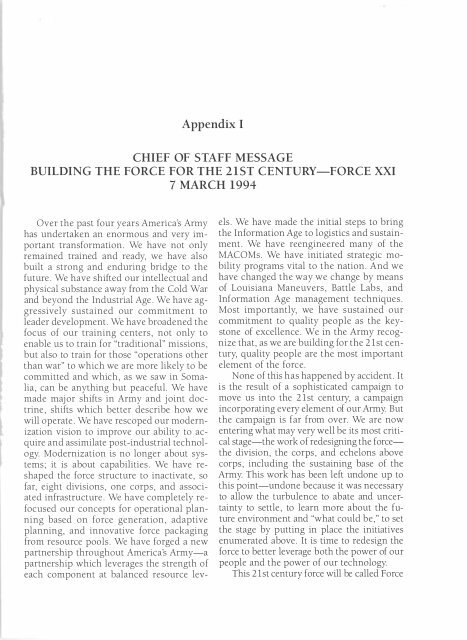The Modern Louisiana Maneuvers - US Army Center Of Military History
The Modern Louisiana Maneuvers - US Army Center Of Military History
The Modern Louisiana Maneuvers - US Army Center Of Military History
Create successful ePaper yourself
Turn your PDF publications into a flip-book with our unique Google optimized e-Paper software.
Appendix I<br />
CHIEF OF STAFF MESSAGE<br />
BUILDING THE FORCE FOR THE 21ST CENTURY-FORCE XXI<br />
Over the past four years America's <strong>Army</strong><br />
has undertaken an enormous and very important<br />
transformation. We have not only<br />
remained trained and ready, we have also<br />
built a strong and enduring bridge to the<br />
future. We have shifted our intellectual and<br />
physical substance away from the Cold War<br />
and beyond the Industrial Age. We have aggressively<br />
sustained our commitment to<br />
leader development. We have broadened the<br />
focus of our training centers, not only to<br />
enable us to train for "traditional" missions,<br />
but also to train for those "operations other<br />
than war" to which we are more likely to be<br />
committed and which, as we saw in Somalia,<br />
can be anything but peaceful. We have<br />
made major shifts in <strong>Army</strong> and joint doctrine,<br />
shifts which better describe how we<br />
will operate. We have rescoped our modernization<br />
vision to improve our ability to acquire<br />
and assimilate post-industrial technology.<br />
<strong>Modern</strong>ization is no longer about systems;<br />
it is about capabilities. We have reshaped<br />
the force structure to inactivate, so<br />
far, eight divisions, one corps, and associated<br />
infrastructure. We have completely refocused<br />
our concepts for operational planning<br />
based on force generation, adaptive<br />
planning, and innovative force packaging<br />
from resource pools. We have forged a new<br />
partnership throughout America's <strong>Army</strong>-a<br />
partnership which leverages the strength of<br />
each component at balanced resource lev-<br />
7 MARCH 1994<br />
els. We have made the initial steps to bring<br />
the Information Age to logistics and sustainment.<br />
We have reengineered many of the<br />
MACOMs. We have initiated strategic mobility<br />
programs vital to the nation. And we<br />
have changed the way we change by means<br />
of <strong>Louisiana</strong> <strong>Maneuvers</strong>, Battle Labs, and<br />
Information Age management techniques.<br />
Most importantly, we have sustained our<br />
commitment to quality people as the keystone<br />
of excellence. We in the <strong>Army</strong> recognize<br />
that, as we are building for the 21st century,<br />
quality people are the most important<br />
element of the force.<br />
None of this has happened by accident. It<br />
is the result of a sophisticated campaign to<br />
move us into the 21st century, a campaign<br />
incorporating every element of our <strong>Army</strong>. But<br />
the campaign is far from over. We are now<br />
entering what may very well be its most critical<br />
stage-the work of redesigning the forcethe<br />
division, the corps, and echelons above<br />
corps, including the sustaining base of the<br />
<strong>Army</strong>. This work has been left undone up to<br />
this paint-undone because it was necessary<br />
to allow the turbulence to abate and uncertainty<br />
to settle, to learn more about the future<br />
environment and "what could be," to set<br />
the stage by putting in place the initiatives<br />
enumerated above. It is time to redesign the<br />
force to better leverage both the power of our<br />
people and the power of our technology.<br />
This 21st century force will be called Force
















